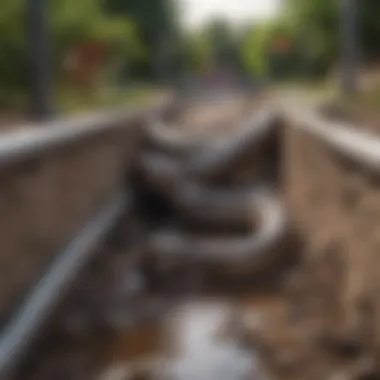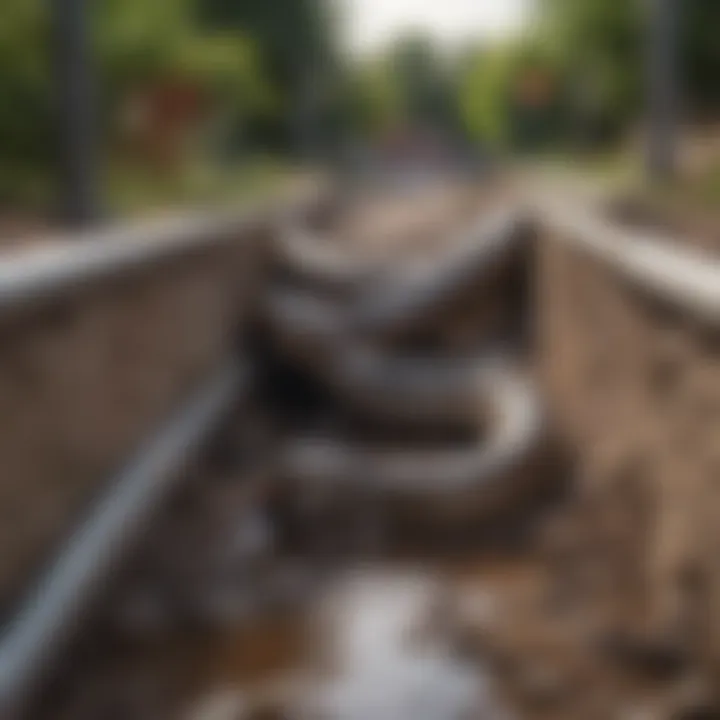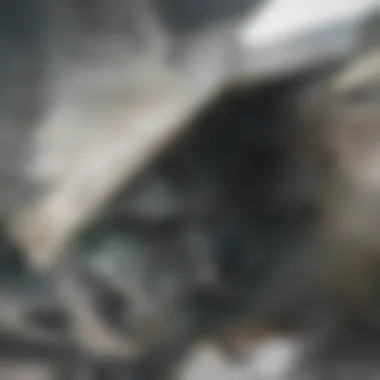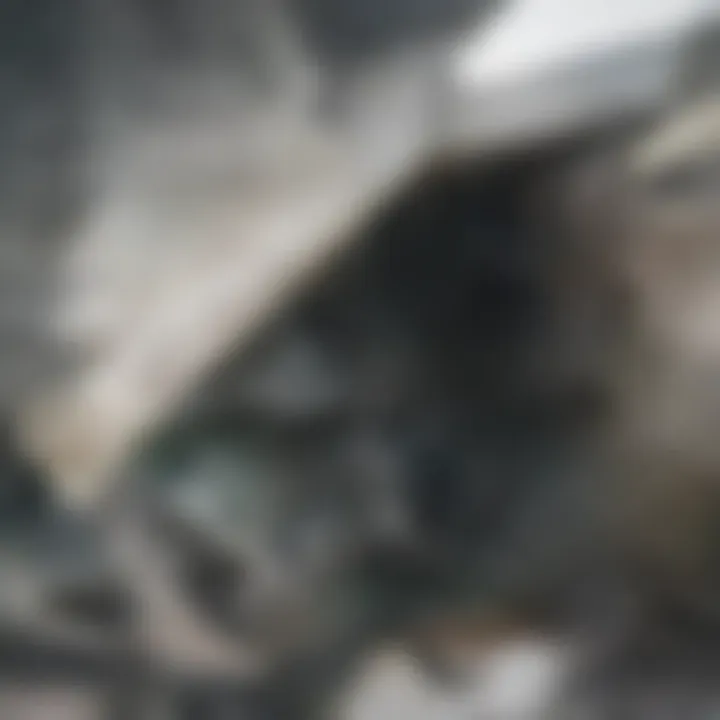Understanding Garbage Disposals and Drain Snaking


Intro
The collaboration between garbage disposals and drain snaking is often overlooked yet essential for effective home maintenance. Understanding how these two systems interact unveils crucial insights for homeowners and property managers alike. Many people question the compatibility of drain snakes and garbage disposals. Can a drain snake clear a blockage in a sink that has a disposal? What issues can arise? This discussion is vital for maintaining clean and efficient plumbing systems.
Garbage disposals serve as a convenient way to process food waste, allowing for easy disposal and reducing landfill contributions. However, when clogs occur, homeowners may worry about using a drain snake due to the potential for damage. This article will navigate the relationship between these two entities, discussing their functions, compatibility, and maintenance tips. Readers will leave with enhanced knowledge on how to handle common drainage problems effectively, ultimately leading to more informed decisions regarding their plumbing systems.
Furthermore, as we explore this intersection, we will examine the misconceptions that often cloud homeowners' understanding of how to maintain their disposal systems properly. By setting the record straight, we aim to equip our audience with actionable insights that can prevent costly repairs and improve the longevity of their plumbing installations.
Prelims to Garbage Disposals
Garbage disposals have become a common fixture in many kitchens. They offer convenience and help with waste management, thereby improving hygiene. This section explores their significance in relation to drain maintenance, particularly when issues arise. Effective waste disposal systems can prevent complications that might lead to costly plumbing repairs. Knowing how to use a garbage disposal properly and recognizing its limitations is essential for all homeowners.
Overview of Functionality
The core function of a garbage disposal is to shred food waste into smaller pieces. This allows waste to pass more easily through plumbing systems. When food scraps are ground down, they are often flushed into the drain, significantly reducing the volume of waste that goes to landfills. With models available that utilize different types of motors, each unit may operate with varying levels of efficiency and noise. Generally, garbage disposals consist of key components such as the motor, grinding chamber, and drain connections. Proper usage and understanding of these parts ensure that each unit works effectively, minimizing the risk of blockages.
Common Types of Garbage Disposals
Several variations of garbage disposals exist for different needs:
- Continuous Feed Disposals: These units are the most popular. They allow users to keep the disposal running while feeding waste continuously. This design boosts efficiency but can be noisy.
- Batch Feed Disposals: In contrast, these units require users to cover the outlet before operation. This design is safer, making it an excellent choice for households with children, but it might take more time to process waste.
- Commercial Disposal Systems: These heavy-duty models serve restaurants and food service operations. They are built to handle large volumes of waste efficiently.
Each type comes with its advantages and disadvantages, which need consideration based on one's specific usage requirements and kitchen setup. Understanding functionality and types helps homeowners choose the right model, ultimately leading to effective drain maintenance.
Functionality of a Drain Snake
The effectiveness of a drain snake is a crucial aspect when addressing plumbing issues linked to garbage disposals. This tool plays an integral role in maintaining the overall functionality of plumbing systems. Understanding the mechanics of a drain snake can enhance your ability to deal with potential clogs effectively. This section will explore the mechanism of action of a drain snake and the materials and tools commonly used.
Mechanism of Action
A drain snake, also known as a plumbing snake or auger, serves one primary purpose: clearing clogs. Its construction allows it to navigate through the twists and turns of plumbing systems. The core function lies in its flexible metal coil that can reach deep into pipes now blocked by debris or buildup. When the snake is inserted into a drain, the operator turns the handle. This action causes the coil to rotate and move forward, breaking up the obstruction in the line. As it scrapes against the inner walls of the pipe, it helps dislodge stubborn materials.
The utility of a drain snake extends beyond merely removing clogs. Regular use can help maintain drain flow by preventing build-up. However, it's worth noting that a snaked drain does not serve as a permanent fix. Routine checks and maintenance must also be in place to ensure systems remain unblocked and functional.
Materials and Tools Used
Understanding the materials and tools involved in using a drain snake is essential for effective operation. Here’s a list of the key components:
- Cable: Made of flexible metal, the cable is the core part of a drain snake. It comes in various thicknesses and lengths to suit different drainage systems.
- Handle: This is attached to the outer part of the snake. The handle allows the user to operate the snake by rotating it to move the cable forward.
- Auger Head: Some drain snakes come with an auger head attachment. It enhances the snake's ability to break apart clogs by digging into the obstruction.
- Drain Accessible Tools: Tools such as a bucket, pliers, and gloves aid in managing the debris that may surface following a snaking operation.
Using these materials properly maximizes the snake's efficiency and effectiveness, making it an invaluable tool for homeowners and property maintenance professionals alike.
The Relationship Between Garbage Disposals and Drains
Understanding how garbage disposals interact with drain systems is essential for homeowners and property maintainers. The relationship between these two components often dictates the health of a plumbing system. Neglecting this interaction can lead to various complications, affecting not only the disposals' functionality but also the overall drainage system.
Garbage disposals help in breaking down food waste into smaller particles, which then flow through the plumbing. When functioning correctly, they provide convenience and contribute to a cleaner kitchen environment. However, their operation can also impact the efficiency of the drains. If too much waste or inappropriate materials are sent down the disposal, this can lead to clogs or slow drainage.
To grasp this relationship fully, it is critical to consider both the benefits and potential drawbacks. Proper use of garbage disposals can minimize organic waste in landfills and prevent foul odors in kitchens. On the other hand, maintaining an awareness of what should not be disposed of is equally important.
How Disposals Impact Drain Function
The functioning of a garbage disposal significantly influences how well drains perform. When a disposal is in use, it generates a flow of water, which assists in pushing food particles down the drain. However, if these particles are large or fibrous, they can create a blockage. This is particularly true if the disposal isn’t powerful enough to handle certain types of waste, such as celery fibers or large bone fragments.
Furthermore, the continuous breakdown of food waste generates sludge over time, which can adhere to the pipe walls, gradually narrowing the plumbing. Homeowners should periodically check the performance of their disposal unit and ensure it is effectively grinding down waste before it reaches the drains.


Important: Regular maintenance of both the disposal and the drains can prevent potential issues stemming from their interaction.
Potential Blockages in the System
Blockages within the drainage system can often be traced back to improper garbage disposal usage. Common culprits include excessive amounts of starchy foods that, when combined with water, can create a thick paste that sticks to pipes. Cooking oils and grease are also notorious for solidifying and causing clogs.
To minimize blockages, consider the following practices:
- Avoid disposing of certain materials: Starchy foods, grease, fibrous vegetables, and non-food items should not be put into the disposal.
- Utilize cold water: Running cold water while operating the disposal helps in solidifying any grease, allowing it to be chopped up and flushed away more easily.
- Regularly check for clogs: Be proactive in inspecting the drain system for any potential signs of blockage.
- Use the disposal regularly: Frequent use can help keep the waste moving through the pipes, reducing the chance for buildup.
Ultimately, understanding the relationship between garbage disposals and drains is vital for effective home maintenance. Knowledge of their interactions and potential issues enables homeowners to mitigate risks and enhance the overall efficiency of their plumbing systems.
Can You Snake a Drain with a Garbage Disposal?
The intersection of garbage disposals and drain snaking holds significant importance for homeowners dealing with plumbing issues. Understanding whether a drain snake can be effectively used with a garbage disposal is essential for maintaining a functional kitchen system. A garbage disposal is designed to shred food waste, allowing it to pass safely through the plumbing. However, issues can arise when larger pieces of waste cause clogs further down the line. This raises a critical question: Can one use a drain snake in such circumstances? To tackle this, it is crucial to explore both the feasibility as well as the limitations of the method.
Feasibility and Limitations
Using a drain snake on a system equipped with a garbage disposal is possible, but it’s not always straightforward. A few key points to consider include:
- Compatibility: Not all drain snakes are suited for use with a garbage disposal system. Some designs excel in clearing clogs from traditional plumbing, while others focus on minimizing damage to the disposal unit.
- Type of Clog: The nature of the clog matters. If it’s a hard blockage near the disposal, a snake may be effective. However, soft blockages, often caused by grease or food remnants, might require different approaches.
- Access Points: Using a snake usually requires access to the drain line. If the disposal is in place, accessing the drain may be complicated without removing the unit.
- Risk of Damage: Care must be taken to avoid damaging the disposal while snaking. Metal snakes may scratch or damage the unit or run the risk of dislodging parts.
Overall, while feasible, there are limitations that require careful consideration before attempting to snake a drain with a garbage disposal.
Step-by-Step Snaking Process
When addressing a clog with a snake, following a clear process is vital to ensure effectiveness and minimize risks. Here’s a straightforward outline:
- Safety First: Always turn off the power to the garbage disposal. This can often be done at the circuit breaker.
- Gather Tools: You will need a drain snake, a bucket to catch any water or debris, and possibly a wrench for removing plumbing connections.
- Remove Disposal: If possible, disconnect and remove the disposal to access the drain pipe more easily.
- Insert the Snake: Carefully insert the snake into the drain, pushing until resistance is felt, indicating the clog.
- Activate the Snake: Turn the handle to break up the clog. Be patient; adjusting the position might be necessary to fully tackle the blockage.
- Extract the Snake: Pull the snake out gently to avoid damaging the plumbing. Inspect it for debris, which can provide clues about the clog material.
- Reconnect and Test: If the disposal was removed, reconnect it. Then run water through the system to ensure proper drainage.
Note: If the clog persists or if uncertain about performing this yourself, it’s advisable to consult a plumbing professional.
By adhering to this structured approach, homeowners can effectively use a drain snake in conjunction with a garbage disposal, addressing clogs while safeguarding their plumbing systems. Proper knowledge and preparedness help ensure smooth drainage and the longevity of these valuable kitchen components.
Safety Concerns and Precautions
Understanding the safety concerns of using garbage disposals and drain snakes is vital to prevent potential dangers during maintenance tasks. Both appliances involve electricity and moving parts, which can pose risks if not handled correctly. Awareness of these issues allows homeowners to perform maintenance safely and effectively, reducing the likelihood of accidents.
Electrical Hazards
Electricity and water are a dangerous combination. When dealing with a garbage disposal, it is essential to turn off the power at the circuit breaker. This prevents electrical shocks that can occur if the disposal accidentally turns on while a person is working on it. Before touching any wiring or connections, ensure that the power is entirely disconnected.
One common mistake is neglecting to unplug the unit. Even when the breaker is off, the possibility of power remaining through faulty wiring exists. Utilize a multimeter to guarantee there’s no residual voltage. Familiarity with electrical systems mitigates this risk.
Key points to consider include:
- Always disconnect the power source.
- Use tools with insulated handles.
- Consult with a professional if unsure about any electrical aspects.
Physical Risks Involved
The act of snaking a drain presents several physical hazards. Handling a drain snake can lead to injuries if not done properly. These tools can have sharp ends and can injure if used carelessly. Ensure proper grip and control to avoid slips. Additionally, the physical strain of maneuvering the snake can lead to repetitive strain injuries, especially for individuals not accustomed to such tasks.
Another aspect to be cautious about is when a blockage is released within the pipes. Debris may shoot back out of the drain unexpectedly, potentially causing injury. Proper positioning and wearing safety goggles can provide essential protection against these risks.
Physical safety tips include:


- Wear gloves to protect your hands.
- Use goggles to shield the eyes from splashes.
- Maintain a stable posture to avoid strain.
Proper precautions help safeguard against injury and ensure a safer working environment.
In summary, when dealing with garbage disposals and drain snakes, it is crucial to remain vigilant about electrical and physical hazards. Adopting best practices greatly reduces the risk of accidents, ensuring that maintenance tasks proceed without incident.
Effective Maintenance Strategies
Effective maintenance strategies for garbage disposals and drain systems are essential to ensure their proper functioning and longevity. These strategies not only minimize the risk of clogs but also enhance the efficiency of both systems. Regular attention to maintenance can save homeowners considerable costs associated with repairs and replacements. In this section, we will explore key practices that should be implemented to achieve optimal performance.
Regular Cleaning Practices
Regular cleaning practices are critical to maintaining a functional garbage disposal. Over time, food particles and residue can accumulate, leading to odor issues and inefficiency. One effective method is to frequently use cold water while running the disposal. This helps solidify any grease or fat that may have entered the system, allowing it to be ground and flushed away effectively.
Another important cleaning strategy involves utilizing safe cleaning agents. For example, using a mixture of vinegar and baking soda can not only eliminate odors but also break down buildup. This method is simple: pour half a cup of baking soda down the disposal, followed by half a cup of vinegar. Wait a few minutes before flushing the system with cold water. This practice should be done monthly to maintain cleanliness.
Regular cleaning prevents unpleasant smells and inefficiencies in the system.
Having a routine schedule for cleaning can make maintenance manageable, integrating it easily into household chores. Using ice cubes made from vinegar can also serve as a practical cleaner. Simply grind them in the disposal to remove buildup.
Signs of Trouble with the Disposal
Identifying signs of trouble with a garbage disposal can prevent further damage and costly repairs. Homeowners should be mindful of certain indicators that suggest the disposal may not be working as it should. One of the first signs to notice is unusual noises. Grinding or rattling sounds can indicate foreign objects in the disposal or a malfunctioning component.
Another clear warning sign is persistent odors. If the disposal emits a foul odor, this may signal trapped food particles. Cleaning should be initiated immediately to prevent any possible issues.
Leaks can also be a troubling sign. If there is water pooling under the sink, it may suggest that the disposal is leaking and requires repair.
In some cases, the disposal may stop working altogether. If the reset button must be pressed regularly, it may indicate a problem within the system that needs professional attention.
By maintaining an attentive approach towards these signs, homeowners can address issues promptly and effectively, avoiding more severe complications.
Expert Opinions on Drain Care
The intersection of garbage disposals and drain snaking necessitates a nuanced understanding from plumbing professionals. Expert opinions play a pivotal role in ensuring homeowners adopt effective practices for drain care. Understanding the functionality of these systems can help alleviate problems before they escalate into significant issues.
Interviews with Plumbing Professionals
Interviews with plumbing professionals reveal valuable insights into the intricacies of drain care. Many plumbers advocate for regular maintenance to preempt clogs. They emphasize that a garbage disposal should not be treated as a trash can; improper use can lead to blockages affecting the overall drain system. Experts recommend the following practices:
- Avoid putting fibrous materials like celery or onion skins in the disposal.
- Run cold water while using the disposal to help flush food particles.
- Use the disposal regularly to keep components lubricated and functioning effectively.
Plumbers also often point out that familiarity with common drainage problems can save time and money. By conducting routine inspections, homeowners can identify issues like slow drainage or unusual noises early on. Such awareness leads to prompt action and less reliance on emergency services.
Common Advice for Homeowners
Homeowners often seek recommendations from plumbing experts on maintaining their garbage disposals and drainage systems. Here are some common pieces of advice:
- Use Baking Soda and Vinegar: A natural method to clean the disposal is to pour baking soda followed by vinegar down the drain. This combination can help dissolve buildup and unpleasant odors.
- Monthly Inspections: Conduct monthly visual checks of exposed plumbing. This practice helps spot wear or leaks in advance.
- Be Mindful of What Goes Down the Drain: Understanding what can and cannot go into a garbage disposal is crucial. Items like fats, oils, and grease should be avoided.
Effective drain maintenance is not only about avoiding clogs but also prolonging the life of your plumbing system.
Understanding these tips and the dynamics of drain systems can significantly impact the longevity of the disposal and reduce the frequency of plumbing emergencies. By leveraging expert opinions, homeowners can navigate the complexities of drain systems with greater confidence and knowledge.
Alternative Approaches to Clearing Drains
In the world of household maintenance, the significance of understanding various methods to clear drains cannot be overstated. This topic offers insights into alternatives that homeowners can utilize when faced with stubborn clogs. While a drain snake serves as a useful tool in managing blockages, there are other viable options available. Each choice comes with specific benefits and considerations that should be evaluated. Knowing them expands the toolkit for homeowners, allowing for flexibility in addressing drainage issues effectively.


Chemical Drain Cleaners
Chemical drain cleaners represent an accessible option for many homeowners grappling with clogs. These products typically contain caustic substances designed to dissolve organic matter, hair, grease, and other debris that often contribute to blockages. Popular brands like Drano and Liquid-Plumr are commonly found on store shelves.
- Benefits:
- Considerations:
- Quick action: Many chemical cleaners offer rapid relief.
- Ease of use: Simply pour down the drain according to instructions.
- Availability: These products are widely accessible in retail outlets.
- Safety concerns: Caustic chemicals can be harmful if mishandled, posing risks to skin and eyes. Proper protective gear like gloves should be worn.
- Potential damage: Some harsh chemicals can degrade pipes over time, particularly if used excessively or on older plumbing.
- Limited effectiveness: Chemical cleaners might not work on tough blockages or when the clog is too far down the line.
In summary, while chemical drain cleaners can provide immediate solutions, they necessitate caution and awareness of potential long-term consequences on plumbing systems.
Professional Drain Services
When faced with persistent drainage issues, enlisting professional drain services is often the most prudent approach. Plumbers equipped with specialized tools and techniques can address problems beyond the reach of conventional methods, including drain snakes and chemical cleaners.
- Benefits:
- Considerations:
- Expertise: Professionals possess in-depth knowledge of various systems, ensuring appropriate methods are employed.
- Advanced tools: Equipment such as hydro-jetting and camera inspections allows for thorough diagnosis and resolution of issues.
- Comprehensive solutions: Professionals can identify underlying problems, ensuring that the root cause is addressed, rather than merely alleviating symptoms.
- Cost: Hiring a professional can be more expensive than DIY methods. However, the investment often results in permanent solutions, avoiding recurring issues.
- Scheduling: Availability may vary, and wait times could lead to temporary inconveniences.
- Trust and reliability: Selecting a trusted professional is crucial. Verifying credentials and customer reviews helps ensure quality service.
Understanding the nuances of these approaches not only aids in effective home maintenance but also empowers homeowners to make informed decisions tailored to their unique situations.
Case Studies and Real-Life Experiences
Understanding how garbage disposals and drain snaking interact can be made clearer through real-life examples. Case studies provide concrete evidence of common problems that arise and solutions that homeowners have successfully implemented. Analyzing these scenarios helps to highlight the effectiveness of maintenance strategies and ideal approaches to dealing with plumbing issues. They also illustrate the complexities involved in managing waste disposal systems in residential settings.
Various real-life studies have extracted meaningful insights that demonstrate the do's and don'ts of integrating a garbage disposal with sink drains. Homeowners who share their experiences contribute to a broader understanding of effective strategies, equipment usage, and the potential pitfalls to avoid.
In particular, case studies serve as a valuable resource for individuals requiring practical advice. Rather than relying solely on theoretical knowledge, these stories show real outcomes, making the information much more relatable and applicable. The success stories reflect the positive outcomes of correct maintenance and timely intervention. Conversely, the narratives of failures highlight the importance of taking necessary precautions and the potential complications that can arise if issues are ignored or mishandled.
Among other things, these experiences can help homeowners navigate troubleshooting procedures, understand the consequences of improper disposal habits, and recognize when professional services might be necessary. The key is to learn from the collective experiences of others in order to make informed decisions regarding home plumbing systems.
Success Stories
Success stories in this domain often showcase how careful planning and proactive maintenance can prevent major plumbing issues. Many homeowners report their positive experiences with regularly scheduled maintenance checks of their garbage disposals, which can hinder the need for more serious interventions later.
For example, a family in Texas noted that by monthly cleaning of their disposal, using a mixture of ice and salt, they managed to keep it in optimal condition. They shared that this practice not only minimized odors but also reduced the likelihood of clogs in the drain. The maintenance strategy paid off when a neighbor experienced severe drain issues due to neglect, while they had no such worries.
In another instance, a couple in California faced slow drainage resulting from a buildup of food waste in their disposal. After hiring a plumber who expertly snaked the drain, they took the advice of the professional. They committed to a disposal-safe diet, avoiding problematic items like fibrous vegetables that had previously contributed to their issues. Since then, they have enjoyed a trouble-free experience and advocate for the combination of professional help and sound disposal practices.
"Preventive maintenance leads to long-term savings and peace of mind."
– Anonymous Homeowner
Failures and Lessons Learned
While success stories are uplifting, failures present crucial lessons. Various cases show how ignorance of proper disposal methods can turn into significant issues. One homeowner from Florida discovered that using their garbage disposal for non-disposal-friendly materials created an overwhelming blockage which ultimately resulted in costly plumbing repairs. This situation underscored the importance of knowing what can safely go down the disposal.
Another alarming case involved a homeowner trying to clear a blockage caused by a poorly maintained garbage disposal. The individual attempted to use a drain snake without adequately understanding how to operate it correctly. This led to damage of the disposal unit, resulting in an eventual replacement which was far more expensive than hiring a professional initially.
Such failures highlight the importance of adhering to best practices around usage and maintenance. Homeowners who learn from both personal and shared mistakes can better appreciate the dynamics between garbage disposals and drain systems. Awareness of potential mishaps can motivate cautious approaches, ensuring fewer problems arise in the future. It remains essential for homeowners to combine regular maintenance with informed disposal habits to avert costly repairs or replacements.
End
In this article, we examined the critical relationship between garbage disposals and drain snaking, emphasizing the need to understand both systems for effective home maintenance. Knowing how these units function and their potential issues can save homeowners time and money. Proper maintenance not only prolongs the life of these systems but also ensures a smooth and efficient disposal and drainage process.
Summary of Key Points
- Functionality of Systems: Garbage disposals and drain snakes serve distinct yet interconnected roles in kitchen plumbing. Understanding these functions helps in managing issues effectively.
- Impact of Misuse: Incorrect use of either system can lead to blockages and costly repairs. Recognizing the limitations of garbage disposals regarding what waste they can handle is crucial.
- Maintenance Practices: Regular cleaning and the ability to identify early signs of trouble can prevent significant malfunctions, enhancing the longevity of both systems.
- Professional Insights: Input from plumbing professionals highlighted common pitfalls and best practices for maintaining these systems in tandem.
- Alternative Strategies: We explored various methods for clearing drains, emphasizing that sometimes professional help or alternative solutions may be necessary.
Final Thoughts on Drain Maintenance
Maintaining a garbage disposal and associated drainage systems requires informed action and vigilance. Homeowners should prioritize regular checks and cleaning routines to mitigate issues before they escalate. Additionally, keeping abreast of expert recommendations can further enhance the approach to home plumbing. Following a proactive maintenance strategy can help avert major problems, ensuring that both solutions work harmoniously.















